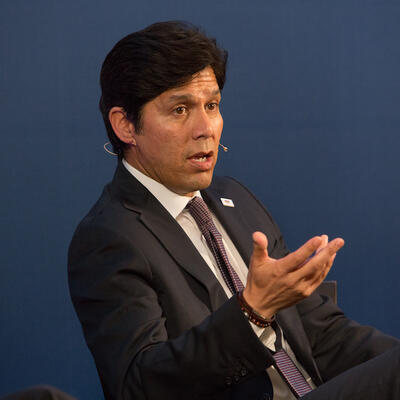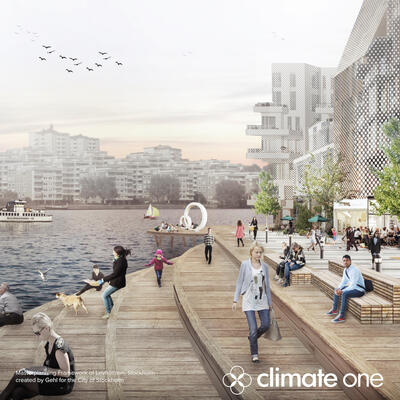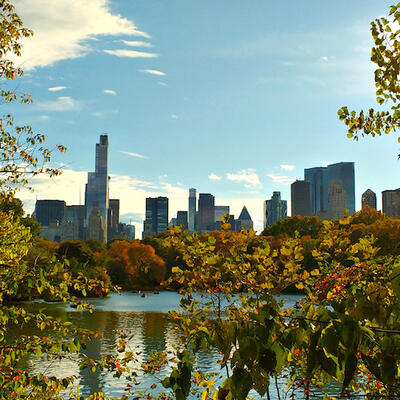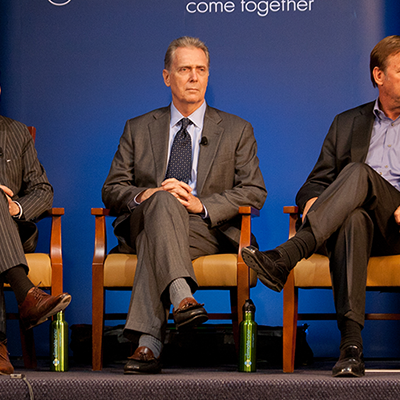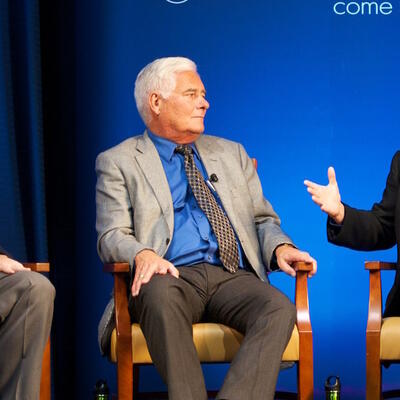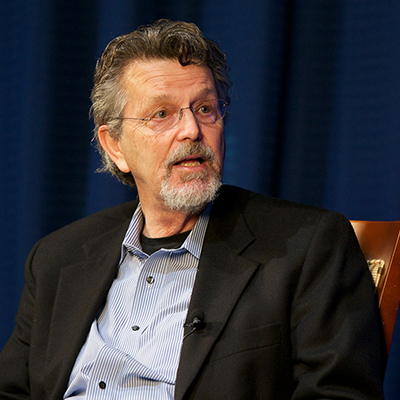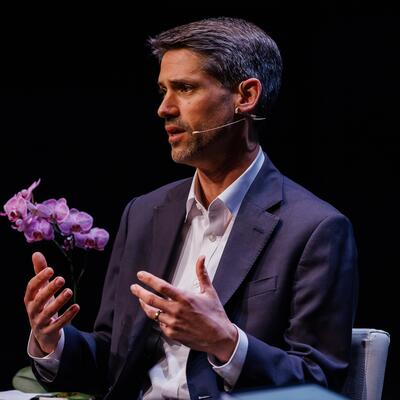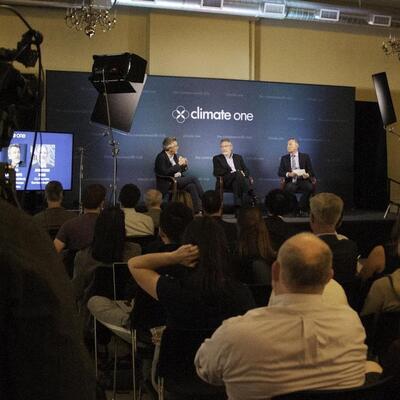
Future Cities
Guests
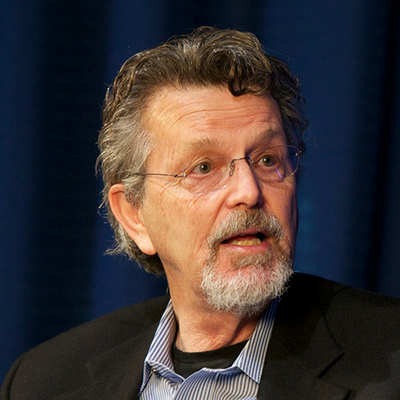
Peter Calthorpe
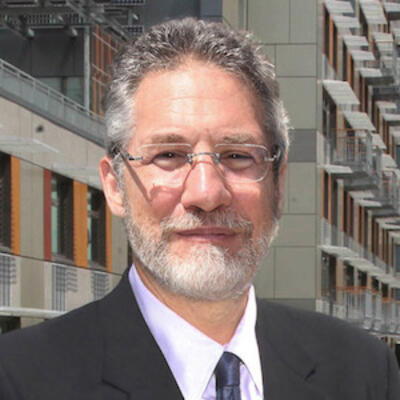
Jonathan F.P. Rose
Summary
As the world’s population increasingly moves into cities, what is the future of urban life? How can we build in the ability to weather a changing climate?
Jonathan F.P. Rose, Co-Founder, Garrison Institute
Peter Calthorpe, Principal Architect, Peter Calthorpe Associates
This program was recorded in front of a live audience at the Commonwealth Club of California on September 21, 2016.
Full Transcript
Greg Dalton: From the Commonwealth Club of California this is Climate One, leading the conversation about America's energy, economy and environment. I'm Greg Dalton.
Today we’re discussing the history of cities and the future of urban life in a world that is hot, flat and crowded. More people are living in cities than ever before and in China 350 million people are moving into dense urban areas in one of the biggest demographic shifts in human history. How those communities are formed and powered will have a significant impact on the future of China and the air quality and climate in the United States. Pollution from Shanghai and Beijing after all travels to San Francisco and beyond.
Over the next hour we will discuss urban parks and farms, microgrids and living buildings, dynamic urban planning that adapts to changing coastlines and severe weather delivered by a volatile climate. We’re joined by two visionary authors who write and think deeply about urban communities in the United States, China and around the world. Peter Calthorpe is an architect and urban planner who has championed walkable communities and transit oriented development. He works in California and China on shaping land use and property development in ways that increase the quality of life and decrease carbon pollution. His latest book is “Urbanism in the Age of Climate Change.”
Jonathan Rose has a real estate development planning and investment firm. He previously chaired a commission created to reduce the carbon footprint of New York City's huge transit system. With his wife Diana Calthorpe Rose, yes, that's Peter’s sister, Jonathan cofounded the Garrison Institute and created his climate mind and behavior program. His new book is “The Well-Tempered City: What Modern Science, Ancient Civilizations, and Human Nature Teach Us about the Future of Urban Life.” Please welcome them both to Climate One.
[Applause]
Jonathan Rose, you write that the key to the future of cities is found in the past. So tell us about some of the, how you opened your book, you touched on Jericho and other ancient civilizations and how they can inform where we are today.
Jonathan F.P. Rose: So I’m going to talk about a lesson from the deep past really before civilization began. It's a climate story and it’s one of the reasons why civilization began. So we see, the book traces the evolution of humans and moving toward cities starting 50,000 BC. But about 10,000 BC there is a climate incident in which all of a sudden the climate became much colder. And what happened was the grains that were then available adapted, those that couldn't adapt of course died or diminished; they had a much shorter growing season.
And so what they had to do was grow a much bigger seed head and had to actually grow a harder coating around it to protect the seed head from the winter in effect and that bigger seed head had many more calories and nutrients in it. And that's with the grains had to protect themselves but all of a sudden -- so you ask why did agriculture take place when it took place. There are many reasons. Part had to do with technology and, it actually had to do with cognition how we actually understood things. But it turns out until that moment, there really weren’t grains worth agriculting for with, you know, growing. (0:10:00)
After that there were these incredibly powerful caloric and nutritious grains. They were created by climate change. That period was about 300 years and when that period was over, all of the sudden the beginnings of civilization really expanded.
Greg Dalton: So climate change happened in a way that human civilization adapted positively. And we'll talk later about some more challenging adaptations to climate.
Jonathan F.P. Rose: But, so what we see is that climate change always transforms the natural ecology and leaves things differently afterwards. And so what we really need to do is to increase the adaptive capacity of our current civilization to adapt to the climate change. That was naturally occurring climate change. This is climate change that we have created.
Greg Dalton: You also write a little bit about how naturally civilization developed near waterways, coastlines that sort of things. Tell us about how important that is and today we’ll get the sea level rise in some of Peter's work.
Jonathan F.P. Rose: So one of the key elements of civilization was actually is connectivity. And we see this today by the way in modern economies that are dramatically shifting with the more connected city is the better it’s going to do. It is now for the whole emergence of civilization came from small towns that begin the trading connecting created what was called an interaction sphere. And coastlines have been the traditional launching points for a larger interaction sphere of trade and commerce and the exchange of ideas.
Greg Dalton: And Peter Calthorpe, now most Americans live along the coast. A lot of the large most major cities are on the coast or a major waterway. You’re a champion of developing those cities in a more livable human way. How do you see where we are right now in terms of this stage of increasing urbanism, and increased density along the coast?
Peter Calthorpe: Well, I never like to reduce climate change to sea level rise. I mean everybody seems to think that it's the one and only negative impact. But there are so many negative impacts that you have to focus on. To single one out is always a bit of a mistake.
Greg Dalton: Well I can give you a long list. I’d make a career of doing that.
Peter Calthorpe: Yeah, I mean, you know, there’s so many issues that we have to resolve. But cities in general are really the vessel of the future of mankind. I mean this country transition from agrarian population, 98% to where we are now. China is going through exactly the same transition. And we all know the earth is urbanizing. The question is what kind of cities and what kind of lifestyles and what kind of urban footprint. What kind of environmental weight will we put down there?
Lot of people like to think of cities like typical, now I would say Manhattan has the lowest carbon footprint per capita, absolutely correct, but density is not enough. These cities have to be walkable. They have to be well-connected as Jonathan points out. They have to be places where people can live lightly. So the difference, let's just look at it here in the United States. In the 60s when we generated our vast middle class and incredible wealth the average household was about 1,100 square feet. Now it's 2,300 square feet. Just the quantity of space to heat and cool is by many factors, per capita greater. We had the luxury of one car per household back then and now it's 2.3.
We were averaging under 10,000 vehicle miles per capita and now it's, you know, for suburban places 26,000 miles. So before we get to all the conservation and renewable energy sources, we have to look deeply at our lifestyles. And our lifestyles are driven in a really creative interactive way by the kinds of environments we live in. The kinds of cities we create. I mean Churchill once said he was referring to buildings of course. But we shape the built environment and then it shapes us. And that's really the challenge of city making and it's foundational to the climate question I think.
Greg Dalton: Jonathan Rose, the density is good for climate, and people have lower carbon footprint. Yet today in San Francisco, in many cities, those are increasingly not affordable. So they are low carbon, but they are high wealth, high income areas. So help us address this equity or inclusion challenge that we’re feeling very painfully in the Bay Area.
Jonathan F.P. Rose: So the answer is you don't have enough density. There is a huge affordable housing issue in San Francisco. Actually, affordability is defined as being able to spend up to 30% of your income on housing and not more. In America today, there are 20 million American families that spend more than 50% of their income on housing. And these are hard-working families.
It's hard to think when you add the cost of transportation and then where I don’t even see how family can pay for healthcare and food and all the other things they need to and spend 50% of your income on housing. So if the goal is 30% of our income on housing, to meet that in San Francisco the median rental or home cost requires an income of $160,000 a year. So there’s a huge affordability gap here. The only way we’re going to solve this is we have to preserve existing affordable housing, but we need to build more. We need to build dramatically more.
The great thing is this area is a job generator, so growth is here and wants to continue to be here. We have to build our way out of it and building our way out of it means much more density and it means mixed income density. Now the interesting thing is that you can add, there's also interestingly to me is there's not a lot of open space in San Francisco. And the open space in the Bay Area is not coherent.
And what you, so you need to put these two things together. What we see in the great cities that are addressing this issue is combining much higher density and much more open space and creating much more livable communities. And these two things can go hand-in-hand. They are not currently politically acceptable, and as long as they remain unacceptable, higher density in San Francisco then we’re going to continue to have an affordable housing problem.
Greg Dalton: Peter Calthorpe, lots of areas are going through this. Lot of people would support what Jonathan Rose just said. Just in someone else's backyard. That happens in the west side of San Francisco, it happens in Palo Alto right now. A great solution for Palo Alto would be to have downtown office residential towers in Palo Alto, walk to Caltrain. Why can’t it happen?
Peter Calthorpe: Well, I do want to just differ a little bit from Jonathan. I think that what we need is urbanism, not density. We need different forms of urbanism and we need to look at this as a regional issue, not just San Francisco issue. The pressure is on San Francisco because people wanted urban lifestyle and it's one of the few places they can get it. And so the wealthy can command what's most desirable. But if we create more places throughout the region intelligently that are urban, we can get them at different scales but the basic quality of being walkable and mixed-use and relatively compact.
We had a beautiful system in the United States prior to the post-World War II sprawl, which was streetcar suburbs. We had fabulous downtowns; we had these beautiful communities that you could get to by trolley. And then you would walk down Main Street over to Elm Street and you'd be home. And there was this connectivity that didn't really lean on the car too much. So there's a vision there in that.
And so the challenge is greater than just San Francisco growing up and growing denser. This challenge is for all the communities in the Bay Area to pick up and satisfy the needs. And there are wealthy communities that basically are saying no, like Palo Alto and Atherton in Menlo Park these places.
They’re in the middle of these job centers. They never say no to a new commercial development or a new office building or new employer. But they sure say no to high density housing and infill housing. And it's very exclusionary and it's very unhealthy. And you're right. I mean there are places all along the peninsula and all throughout the East Bay where we have evolving and increasing transit opportunities that really should become mixed-use nodes and yet local opposition frustrates it.
So I think that we just need to take a regional look at this. There’s a whole issue around jobs housing balance in the Bay Area. Silicon Valley is where all the jobs are and all the people that don't have wealthy salaries end up in the East Bay and beyond. Long commutes, a hugely painful economically and in terms of life for people to have to make those long commutes. Whether they're firemen or teachers or what have you.
And, you know, our highways and our air suffer as a result. So there's a lot of issues packed in there but, you know, I think there are some culprits out there. Cities that are truly exclusionary and they need to be called out. I'm happy to do it.
[Applause]
Greg Dalton: Jonathan Rose, you write about suburban poverty. And also how the sub mortgage sort of machine contributed to that. So tell us how that came together.
Jonathan F.P. Rose: Well, I’m not sure those two things are totally related but the -- well maybe they are. There’s now more suburban poverty in America than there is urban poverty and I mentioned earlier the cost of the automobile. People, and so people who live in the suburbs who are need of a definition of poverty actually are more burdened by their cost of transportation but they are also more burdened by fewer resources.
So if you are poor and striving in inner-city, there are after school programs. There’s a lot more resources for you than there in the suburbs. So it's not a good situation for America. And as Peter has pointed out, the suburbs tend to be places that are less likely to want to deal with it.
And we have to rethink what the suburbs mean too, because we have the inner ring, first ring suburbs. We have a series of aging suburbs with aging infrastructure and many of them are the places that are not attracting the jobs that the more prosperous suburbs are. So they don't have the resources to deal with the growing poverty in their areas also.
Greg Dalton: Bring back this to climate change it sounds like this is another example where green living is yet sort of for the privileged, that you can afford to live the low carbon lifestyle in an urban area. And if you're driving a car living in the suburbs, maybe you don’t have as good food choices. It's another way that the green economy is kind of skewed toward the fortunate.
Jonathan F.P. Rose: I’m not, I wouldn't -- again I wouldn’t just say the green economy is skewed towards the fortunate --
Peter Calthorpe: Everything is skewed towards the wealthy.
Jonathan F.P. Rose: Everything is skewed toward the fortunate, that’s what makes them fortunate. But here's the key, so one of the premises that I really put forward in the book is that we have to equalize the landscape of opportunity. We now know America is deeply divided by a ZIP Code. There are places in the United States in which the healthiest people will live 15 or 20 years longer than in the worst ZIP Codes.
We know that there are ZIP Codes where income is usually divided. We know there’s very interesting data that shows literally opportunity of children there are places in America where if you're born your children are likely to have a lower income than you. And there are places if you’re born statistically your children likely to have a higher income than you.
That has to do with education system, a variety of other things. So we are a deeply fragmented divided nation. I believe that America was conceived of as a land of opportunity. That's our mission statement that’s, if you boil us down that’s what we have to offer the world. And that means we have to equalize the landscape of opportunity for all. To do that means we need to spread affordable housing throughout all communities.
And we need to spread transit equally throughout all committees. We need to spread parks and open space. Education, the quality of education needs to be equalize throughout all over communities. So that you, we should imagine an America where we, where not only every child has a chance to do better. But every child as you’ve started this question with has a chance to live in a greener, healthier way.
Greg Dalton: And how does that spread of affordable housing happen. San Francisco recently passed a mandate increasing the amount of affordable housing. As a developer, do you support those kinds of mandates on developers?
Jonathan F.P. Rose: I totally do and I was very active in lobbying in Denver. Last night the city of Denver passed a bill that as an impact fee and spreads the real estate tax throughout all people. I actually believe that the development committee should not be the only community that shares the burden of affordable housing. We need to create much greater subsidy sources for it but so I'm a big supporter of that. And I also deeply believe in mixed-income housing. Mixed-income housing is better for the residents, it’s better, it creates healthy diverse communities.
Greg Dalton: Peter Calthorpe, your vision for more affordable housing. Not just in the Bay Area, but nationally. Does it require public funding, government mandates?
Peter Calthorpe: Well, let me back up. Because I think the issue now is actually bigger than affordable housing.
The middle class can no longer afford the American dream. That's what 2008 taught us. And I actually have a totally different take on that. I don't think it was as much Wall Street as it was the paradigm of development; that the good life was a subdivision, somewhere out at the end of a freeway. And the whole notion of drive until you qualify, you know, so you'll get a cheaper house the farther away you go, and people didn't factor in the cost of all that transportation.
But the reality is we built too much of the wrong stuff. We kept building sprawl, as if that's what we needed. And we had stopped needing it into several decades before in terms of demographics. I mean this country is only 25% families with kids. It's all empty-nesters and single people and much more complex arrangements so the cul-de-sac doesn't fit anymore. When you build too much of the wrong thing, what do you do? You discount it. You put it in a bargain-basement sale, which is what the mortgage strategy was, you know, make it look cheap.
So that, you know, that feeds into a larger issue which is I think we have to solve the problem. Not just for the poor, but for the middle class now. We’re not building the right kind of places for them. And so, and I think that's a good thing because in some level there's inherent solidarity there. If we keep isolating the issue and saying well, it's about affordable housing. I think we’re making a mistake. The truth is, it's about affordable lifestyles for everybody. And, you know, and I think when we see it that way there's actually a larger constituency and a more powerful political movement that you can put in place.
Jonathan F.P. Rose: I agree that we need that is a middle-class movement. And actually the right phrase should be not affordable housing, but housing that is affordable. And there’s a very wide range of people who need to afford housing and it absolutely includes the middle class.
But what I disagree is, so first of all I agree that there really was not suburban demand, but there were a couple things. So first of all, it is exceedingly difficult to get approval to build a new building in San Francisco. And they made it, the communities made it very, very easy to build in the suburban, in these ex-urban locations. So number one, there was unequal landscape of approval opportunity.
The second thing was that there really was mortgage fraud. That those, many of those homes -- so there is complicity between both the communities that were approving it, the developers that were building it, the mortgage brokers that were selling it, the lenders who are lending it, and they were lending with full knowledge that they were lending to people who could not afford those mortgages that they had.
Peter Calthorpe: They were removing unwanted inventory.
Jonathan F.P. Rose: They were creating unwanted inventory.
Peter Calthorpe: Yeah.
Jonathan F.P. Rose: So that they could get the fees on the mortgages. And, but the good news is that is one unwanted inventory and the development community has learned that the market really wants walkable, mixed-use mixed-income, much higher density product they want to be in thriving cities. And so the developers, you know, it’s interesting to me is how many developers that were traditionally suburban developers have become urban developers throughout the United States. They know this is where the market is. Now we have to unleash the capacity to build the greener, walkable transit accessible mixed-income housing that the world wants.
[00:27:30] Greg Dalton: There is a development near my home by KB Homes which is one of the kings of sprawl and they are building here in San Francisco. We’re talking about the future of cities at Climate One with our guests, Jonathan Rose, author of the new book -- Resilient --
Jonathan F.P. Rose: The Well-Tempered City.
Greg Dalton: The Well-Tempered City. What’s the name of your book? And Peter Calthorpe who is the author, architect and urban planner. Peter Calthorpe, I want to ask you about Envision Utah; talk about some positive models. We've gone to some unusual places and done some interesting things in a red state, coal state Utah.
Peter Calthorpe: Well, the real question is I think everybody actually understands who thinks about where we need to get to. The question is how do you break through the logjam of stovepipe politics and stovepipe bureaucracy and stovepipe professions. Everybody's got a single issue to play to and because of the cacophony actually there's very little movement. We see that all the time. It turns out that when you design healthy cities, you get an amazing set of co-benefits. You solve the housing problem, you preserve open space, you reduce air congestion and bad air. You create more affordable lifestyles because people aren't spending as much moving around, all these things.
So this is kind of the green vision, the Portland, you know, West Coast blue state thing. We took this idea to Utah at the invitation of a group which is basically their Chamber of Commerce, not the most progressive group. And this of course is where the Mormons live. And the smallest lot I thought I ever saw out there was quarter of an acre. I mean really large homes on big lots. And we did scenario planning. So we said, we don't have an answer you define several futures you'd like to investigate and we’ll give you the impacts across a range of issues, not just carbon emissions, not just health, not just housing but all the issues.
By having scenarios and having multi-metric analysis, we were able to draw together, unlikely coalitions. So the Mormon Church actually was very concerned with affordable first time home buyers. They wanted their kids to be able to stay. And those big homes on big lots weren't a good stepping stone for that. And so they wanted more housing diversity. They didn't know it but when they saw it they realized it. They are also very sympathetic to walking, the ward system, their whole tradition is walking, that was very nice.
But the conservatives in the legislature bought into smart growth and they are now building the most rapidly expanding transit network along with transit-oriented development in the United States is faster growing than Portland. The state legislature passed a Growth Management Act based on the smart growth idea, why? Because the infrastructure was less expensive, because city services could be accomplished more efficiently. The less spread out you are, the easier police, fire, health, education, everything gets more compact and more efficient.
So they look at it as true fiscal conservatives, which I guess there's few and far between these days. And said, well this is clearly a future that is going to cost the government less and therefore we’re for that. And so you had an alliance between, you know, Republican legislators, the Mormon Church, the environmentalists of course loved it because we got to preserve the Wasatch Back and all this open space. And they literally passed a law with an effective urban growth boundary, delineation of infill and new development areas, very specific, and a whole network of new transit system. So it was a huge success, born of scenario planning and multimetric analysis.
Greg Dalton: Jonathan Rose, as you look out there the positive models. What do you see some exciting models of well-tempered, resilient city? Who's getting it right, that’s an unusual case we just heard from Utah. What are some of your favorite?
Jonathan F.P. Rose: So first of all I want to say it's less and less unusual. And one of the, I'll tell you about a favorite city but I want to just focus on this for a second. So what happened was this, Peter said a business focused citizens group was the founder of this idea. A business focused citizens group hired Daniel Burnham to do the Burnham plan for Chicago, one of the greatest plans of the early 20th century.
A business focused citizens group who had been wealthy enough to tour Europe came back and created Central Park. It very often takes leaders who are independent of government who can host the creation of a big vision, a great vision. And partly what we lack in America today and our cities lack, we get so used to arguing these neighborhood issues and NIMBY-ism and stuff, nobody is putting forth grand visions.
[Applause]
Thank you. So that's really, and the independent sector can do that.
It's good to have a government that also has controls. I want to talk about Singapore. So Singapore, one of their and Peter is talking about codependence, co-benefits and so this is a really great example. Singapore gets most of its water from Malaysia. And they set the goal that by 2080 they’re going to be water independent. And the way they’re going to do that is first they will enforce a lot of water conservation. They use by a third of the water per person as we do in water efficiency et cetera.
But they then said we need to have reservoirs and we’re an island and we’re not that big, so the only way to, and reservoirs are natural areas we need nature to store the water. And the only way to do that is we need more natural areas which means we actually have to condense our sprawl. To condense our sprawl, we actually need to go higher density mixed-use, mixed income. And when we do that high enough, we can connect everything with transit. And by the way, 12% of our land area is used by roads.
So what happened, why don’t we set a goal of reducing that to six or eight and dedicating all that remaining land to open space. So by having this goal of actually becoming water independent all the consequences of that required high density mixed-use, mixed income, greener development and transit. The outcome of that is a much more livable community. And they have then actually said all the open space has to be biodiverse. It’s been an incredible transformation of a thriving city.
Greg Dalton: We’re talking about the future of cities with Jonathan Rose and Peter Calthorpe. I’m Greg Dalton at Climate One.
We’re going to go to our lightning round and ask you a series of short answer yes or no or one-word questions. First for Jonathan Rose, true or false, the 1950s produced no architecture of lasting value?
[Laughter]
Jonathan F.P. Rose: Generally true, but not totally true.
Greg Dalton: Peter Calthorpe, Los Angeles will be a walkable and transit friendly city within 20 years?
Peter Calthorpe: Yes, absolutely.
Greg Dalton: Jonathan Rose, European towns in general are more livable and functional than American towns?
Jonathan F.P. Rose: Yes.
Greg Dalton: Peter Calthorpe, most Americans don't want to live like Europeans with their small homes and cars?
Peter Calthorpe: False.
Greg Dalton: Jonathan Rose, which city in the world has the best cycling culture?
Jonathan F.P. Rose: Copenhagen.
Greg Dalton: This is from a paragraph in your book.
Peter Calthorpe: That's an easy one. Give me one.
[Laughter]
Greg Dalton: Okay, Peter Calthorpe, which has the best subway?
Peter Calthorpe: I would say -- well, geez that’s really hard. The most beautiful is Moscow by far if you are ever been down in it. What did you say best?
Greg Dalton: The best subway system.
Peter Calthorpe: You know, London or New York. Is there a right answer?
Greg Dalton: I agree with Jonathan at least what he wrote in his book, Jonathan?
Jonathan F.P. Rose: I would say New York. What does the book says?
Greg Dalton: The book says Hong Kong.
[Laughter]
Jonathan F.P. Rose: Oh excuse me, okay. Wait, wait okay. We’re in the lightning round I can explain that later.
Greg Dalton: So quickly explain, Hong Kong or New York?
Jonathan F.P. Rose: So it’s actually subway trains. It’s an incredible system because what they did is they not only develop the system, they’re real estate developers. The system is a real estate developer. So everywhere there's a stop. They own all the land around it. And then they developed it, they get all the income from that. So it’s a hugely profitable system and plow that back into the system. So it’s less subway, it’s more train but it's a fantastic system.
Peter Calthorpe: And same is true in Tokyo, in space, which is the rail lines the subway lines on the TOD stations. And, you know, actually when you look at biggest city on the planet has the best air quality in its class of cities and the most mobility. And it's the densest and biggest. So it just shows things can work.
Greg Dalton: Interesting, that combination of land development and transportation. Back to lightning with Jonathan Rose, which city has the most advanced smart grid?
Jonathan F.P. Rose: I don't remember.
Greg Dalton: Austin.
Jonathan F.P. Rose: Thank you. It’s glad somebody read my book.
Greg Dalton: Most green storm water system?
Jonathan F.P. Rose: Philadelphia.
Greg Dalton: And this is easy, best congestion traffic pricing, they are famous for this.
Jonathan F.P. Rose: It’s London.
Greg Dalton: Peter Calthorpe.
Jonathan F.P. Rose: Can I add one more?
Greg Dalton: Sure.
Jonathan F.P. Rose: The highest rated recycling in the world, San Francisco.
[Applause]
Greg Dalton: Peter Calthorpe, the living architect you respect most?
Peter Calthorpe: Oh my gosh.
[Laughter]
The living architect. That makes it really difficult. Can we come back to that later?
Jonathan F.P. Rose: He likes all those guys in the 50s.
Peter Calthorpe: I have a hard time with architects. I think, but there’s a new generation of architects that are finally getting it right. And the whole LEED movement and the focus on green has not only solved energy problems but has made more beautiful buildings. I mean the buildings are much more textured and interesting and memorable than they were. And they're much better to live in. I mean it’s a complete revolution.
So I mean it's hard, they were heading in the right direction I can’t point at the one I love the most. Renzo Piano I will say, you know, who did the work in San Francisco here. I love dearly because he really does care deeply about climate and he has a certain elegance to his work.
Greg Dalton: He, I believe designed the California Academy of Sciences. Jonathan Rose, the living architect you most respect?
Jonathan F.P. Rose: I respect many of them but I’m going to point out this one, I got to go point out two. So, one is Nick Grimshaw who is from England he’s very, very, very green, very community focused, has done amazing transit centers around the world; very technical in his work. And Jeanne Gang from Chicago who’s doing also really interesting urbanism.
Greg Dalton: Peter Calthorpe, the living architect you least respect?
[Laughter]
Peter Calthorpe: That’s easy. Rem Koolhaas.
Greg Dalton: Jonathan Rose, living architect you least respect?
Jonathan F.P. Rose: The living architect that I least respect is actually not one architect. But if you actually think about it most of America is not designed by people like Rem Koolhaas or Nick Grimshaw or any of these people. The mediocrity, so remember the question about the, I know it’s the lightning round but the question about the European villages. The general just general background building is just the ordinary building is so graceful and fitting with the environment and natural made out of local materials and all that. And the general quality of just commercial development in the United States is not.
[Applause]
Greg Dalton: True or false Peter Calthorpe, some of the areas designated for new housing construction along San Francisco Bay will be threatened in the next couple of decades by rising seas?
Peter Calthorpe: Well I think the rising sea. Yes. And the rising -- there’s more to say here. Alright, that’s another one of the collective responsibilities. You cannot solve the sea level rise one place at a time. There needs to be a base, a bay scale solution.
Greg Dalton: This is association, I’ll mention a place or a noun, you just mention what first comes to mind. When I mention, Peter Calthorpe, Millennium Tower.
[Laughter]
Peter Calthorpe: Unfortunate.
Greg Dalton: Peter Calthorpe, Treasure Island.
Peter Calthorpe: A real possibility.
Greg Dalton: Jonathan Rose, the Jersey Shore.
Jonathan F.P. Rose: Subject to climate risk.
Greg Dalton: Still building back right in the same place. Peter Calthorpe, Beijing.
Peter Calthorpe: Oh my god. Lethal.
Greg Dalton: Jonathan Rose, LEED buildings.
Jonathan F.P. Rose: A good step.
Greg Dalton: That’s the end of our lightning round. How they do? Let’s give them a hand for getting through that, the gauntlet of the lightning round.
[Applause]
[CLIMATE ONE MINUTE]
Announcer: When we look toward the cities of the future, what values should we incorporate? Most everyone agrees that in addition to sustainability and resilience, we should foster communities that are livable, walkable, and breathable. And, adds Nile Malloy, former director of Communities for a Better Environment, they should be affordable – for everyone.
Nile Malloy: You know, it’s kind of like a human rights issue. You know people need have a right to housing, healthy food, access to water, you know, we need to figure out what is something affordable to be in the Bay Area. I mean outside of that people are going to be moving out and we see this trend over the last, you know, three or five years that people just, you know, kicked out. Can’t afford it, you know, moving further out east, further north.
And that’s just the reality of what’s going on. I mean San Francisco is probably one of the -- I think one of the richest places in the country by far right now, and there’s gaps, income level gaps. And so we think about bouncing back or being able to respond. You look at all those social inequities in that we have that climate concern.
So it’s a resilience issue in a traditional sense and how you’ll be able to bounce back, you know, have the resources for it. But it’s just also a growing trend that’s happening in the city. I mean, and so climate change is going to keep coming, heat level, you know, all of the different kind of concerns, but the housing is an ongoing issue and there’s lot of organizations towards to fix that.
Announcer: Nile Malloy is a former director of Communities for a Better Environment. He joined us in 2015. Now, back to Greg Dalton and his guests at the Commonwealth Club.
[END CLIMATE ONE MINUTE]
Greg Dalton: Peter Calthorpe, you spent a lot of last six years in China. How China urbanizes is one of the most significant things for stabilizing the climate. Beijing was built on this sort of Stalinist grand boulevard model; Beijing is not a walkable city. Lots of the other cities are still kind of built around the car. Tell us what's going on in China and how they’re going to build the future of the city.
Peter Calthorpe: Well they inherited the Soviet model, which was also the modernist architect’s vision of the 30s, which was towers in the park, super blocks and a huge romance with the car. And they’ve been building it at a pace that’s beyond frightening and of course the results are deadly, literally deadly. So cities that once were dominated by pedestrians and bikes are now really, you know, tragically moved away from that.
And it’s mostly because it's just too dangerous to be out there. Getting to a corner is often a quarter mile walk, getting across the street makes, I think you'd have to take four Market Streets and stack them side-by-side to get a typical major arterial. That's what happens when you build super blocks, you reduce the frequency of streets and so every street gets huge, and of course frustrates walking. So they’re in a downward spiral. They’re building the sprawl, the slums of the future tragically. If our urban renewal and affordable housing fail dramatically I shudder to think what's going to happen to some areas in China.
However, they are fact-based kind of engineer mentality culture. And our group with the Energy Foundation and lots of other people have been proving over and over again that they can afford to keep going in this direction. And as recently as this December from the highest level from the central committee basically for the first time in 37 years issued a new set of urban design standards which said, among other things, we will build small blocks. We will limit the amount of automobile use in cities, we will have targets for both split the transit. Every city will have to comply with. We will have open space and civic centers within walking distance of every new house, I mean a laundry list of best practices I'm happy to say. And it's a little frightening because of course it’s completely top down. I mean this was not any kind of collaborative consensus people oriented political structure. But it is the right direction. And they are setting off in the right direction. They are really serious about solving their air quality and congestion problems.
They understand that their economy can't succeed as it shifts to a more white-collar service economy from an industrial economy. It can't succeed with unlivable cities. And it's not their goal I mean, the goal has been to move people from the countryside where poverty is highest. In the cities where economic opportunity does exist and where services, clinics, schools, running water, sewers, you know, parks all these things really can be delivered.
So at the same time that they’re building the wrong kind of city, this is the biggest shift away from poverty, probably in the history of mankind. So I have to acknowledge that at the same time that we think it could be done better. I think it will be done better and they're very serious about climate change issues, I'm happy to say. And but they see it as related to all these other livability issues. And so very fortunately I think they're shifting into a profoundly better direction.
Jonathan F.P. Rose: So you know, what's interesting is for 3,500 years about 2,000 BC to about 1,500, China had an amazing system of city planning. There was, they didn't vary actually during all that period of time. The buildings got more sophisticated but it was a whole organizational system and was entirely designed around the idea of balancing the forces of humans and nature.
And the idea of harmony was deeply embedded within it. And China now talks about building cities or building their future with what they call Chinese characteristics. And I think the next step is they actually have to look back at the great history of what Chinese characteristics truly were in the past and try and figure out how to integrate those into their future.
Greg Dalton: And I lived in China as a reporter in the 80s. And Peter I hope what you're saying is right that they got the right plans. But anyone who’s spent time in China knows that the local officials, a little money passes hands and they don't, you know, bribery is rampant. And the development there’s a saying that heaven is high --
Jonathan F.P. Rose: I don’t know about the United States --
Greg Dalton: -- and the emperor is far away. So that the people regional level don't always follow those central diktats, but in this case let’s hope that that happens. Peter also mentioned water, Jonathan Rose I want to ask you about water and food supplies with cities because that's something that we've become, these long supply chains where water’s tracked in on diesel powered trucks and in plastic bottles. And get to the future where there is maybe urban farms and food and water is closer to a well-tempered city.
Jonathan F.P. Rose: Right. So 98% of the things that go into a city today in most cities in the world leave six months later as waste. And there's no way that we can have a population of 10 billion people on earth have prosperity increases people describing these people can consume more and have the climate change and this is, it’s totally unsustainable. You know we used to say unsustainable meant like that’s not so good. But unsustainable actually means collapse, without moving from linear systems to circular systems. This was first done in Windhoek which is the capital Namibia, a country in southern Africa, desert city.
And it was rapidly growing and the desert was increasing and they're running out of water. They brought in an engineer who designed the system to take their wastewater and to clean it perfectly and put it back and reuse it as drinking water. That system has run for 40 years without ever a failure. The engineer who designed it said we need to judge water by its quality and not its history. So that's one example of linear systems. We now have water treatment systems that can remove the nitrogen and the phosphorus, which come from the urine in the systems for a $100 a ton. And sell them to fertilizer manufacturers for $400 a ton.
We have water treatment systems that can capture all the methane, burn it, and not only fuel the plant itself, but provide enough energy for thousands of homes. So, what's happening is we’re beginning to rethink, for example, a water treatment plant which was considered a societal negative is now becoming a factory of resources for communities. Now imagine if you take every single aspect of what comes into a city that we have been treating as waste and think about how we can create the infrastructure and turn it into local jobs.
They also design jobs to design these operating jobs and using the resources and create those into jobs. And as we create circular systems it makes the cities much more climate resilient because they're much less dependent upon the resources the world is going to run out of. China by the way, in its central policy in 2012, this is called a circular economy, dedicated itself to a circular economy. We’ll see if they can actually get there. America is way behind in this idea.
Greg Dalton: Now briefly tell us about microgrids and living buildings. How those might be part of this.
Jonathan F.P. Rose: So once you begin to think about circles then you can so, living buildings is an idea that came out of Pacific Northwest. Remember you asked me about LEED and I said it’s a good step, but living buildings is what's next and these are buildings that are actually regenerative of nature, and that they, number one get their energy load and their consumption down very, very low by a lot of insulation really great design.
And then they have a lot of solar that creates energy and they have a lot of, they capture all the rainwater. And if they can recycle that clean it and recycle it through their systems, they become almost independent. But what we need in cities is not independence but interdependence. So imagine if we begin to connect all those kinds of buildings together as a grid and then think of other energy sources.
So we can be using cogeneration, we can be using eventually there’ll be batteries and large capacitors. If we’re using, you know, plug in hybrids whose batteries can be contained use as part of that. And tie these all into energy grids and actually there are two forms of energy. There is the electric energy that powers buildings and there’s also the heat energy when we burn, you know, furnaces and generators and things but also that heat energy can be circulated. There’s a microgrid that’s being built now in Minneapolis between the university and the hospital where they’re exchanging heat in a fantastic loop.
As that happens and you do a multiway just the way Peter writes beautifully about how we need to get from arterials to street grids. When you create energy and heat grids all of a sudden you get some systems that we call self-healing. If one piece breaks there are multiple parts, anyway the bottom line is with a lot of good design and smart data and continues dynamic adjusting these can use far lower amounts of initial energy. The energy they do use can be far more recycled throughout the system and you’ll begin to actually mimic nature.
Greg Dalton: Jonathan Rose is author of the new book “The Well-Tempered City.” He's here with Peter Calthorpe, the architect urban planner and author. I'm Greg Dalton. Jonathan Rose, I want to ask you just one more thing before we go to audience questions. The institute, the Garrison Institute that you founded has a mind, behavior and climate program. Tell us what that aims to do.
Jonathan F.P. Rose: So in looking at the climate issue it is really we act, I just was talking about microgrids; technology is extremely important. Building city form as Peter has been talking about is extremely important. But we also realize is the human behavior is extremely important. And human behavior actually comes from our minds.
So the goal of the climate mind behavior program is to understand and now there’s such amazing new discoveries in neuroscience and social science. Can we understand what are the innate drivers of human behaviors and then can we actually adapt our behaviors so that they are more climate resilient and less climate impactful? And what we discovered is, you can.
Greg Dalton: Let’s go to our audience questions. Welcome to Climate One.
Male Participant: Gary Malaysian [ph]. I don't think you have really a housing problem. I think you have a transportation problem. If you can move people from Oakland to San Francisco in one or two minutes I mean we’re still banking on a 50-year-old BART system which is worn out years ago and you need a better form of moving people.
Now my second point, my question to you is why are we not building larger buildings that enclose all the things that people find in suburbia? For instance, maybe every 10 floors or 20 floors or whatever the system works out to, you build a park, a shopping center, a tennis courts whatever you do out of the building. You're forcing people out of the buildings. Why are we not building buildings that are, you say that comment living buildings, build them big enough so that you can incorporate a city in a building. And then they don't have to move around.
Greg Dalton: Who’d like to tackle that?
Male Participant: They just go up and down the elevator.
Jonathan F.P. Rose: I will take the first one which is about --
Greg Dalton: Jonathan Rose.
Jonathan F.P. Rose: --transportation. We absolutely need a more pervasive transportation system. It needs to be a multilevel trend. We need high-speed rail which I really hope the state continues to do. We need light rail as Peter mentioned. We need a whole range of transportation solutions. But they must be integrated with, it's not only transportation. What you’ve described is but what if we put all the housing in Oakland, Oakland doesn't want all the housing.
We also need this combination of housing, transportation, schools. We actually believe in something we call, with your idea of having everything in one building, we actually, the enterprise community part is a big advocate of something called communities of opportunity. And a community of opportunity is not just a building, it's a neighborhood that has not only affordable housing, has great schools, has great healthcare, has access to mass transit, parks and open space, affordable food, jobs, arts and culture and spiritual resources all in a walkable distance. We think that's what makes sense.
Greg Dalton: We’re talking about the future of cities at Climate One. Let’s have our next question.
Male Participant: Thank you. Good evening. My name is Jeremy. And my question is in regard to your urbanism and density topics. And in terms of policy are there policies in place that like imminent domain that will take the control out of the citizen’s hands and will put into like the elected official’s hands to make choices regarding affordable housing and cities like Palo Alto, San Francisco and the like?
Greg Dalton: Jonathan Rose.
Jonathan F.P. Rose: Interesting question. I actually believe that before we can solve issues through zoning or I'm not a big fan of eminent domain, but through the things like that, we actually need a consciousness change. And the consciousness changes we need to realize that we are all in the climate problem, in the affordable housing problem, in the education problem, we're all in it together.
And there's a lot of data that shows that the more equal a community is and the more that a community is actually compassionate and altruistic and works for the benefit of all, those are the communities that thrive the most. We will never solve these problems if it's all about NIMBY-ism and myself and what’s best for me. In the 1960s, John Kennedy said, ask not what your nation can do for you but what you can do for your nation”.
Martin Luther King said that we're entwined in an amazing web of mutuality. We need both leadership and that view that we are all in this together that's the only we’re going to solve this issues.
Greg Dalton: Next question. Welcome to Climate One.
Male Participant: Hi, just a short background to this question and correct me if I'm wrong, but I feel like Mr. Calthorpe you're asked by a city of Alameda at one point to develop a part of the Naval area station. And then when you present your proposal they rejected everything out of hand. Based on kind of your experience with that and Mr. Rose feel free to add your perspective too, what sort of regulations would you change at a municipal or city level? And what sort of regulations would you change at a national or state level to drive development in a more environmentally and economically inclusive direction?
Greg Dalton: Peter Calthorpe.
Peter Calthorpe: You know the Alameda case study is another one of the exclusionary. They have a Measure A, which literally says that this island will not build any more multi family. Completely illegal and exclusionary but nobody's effectively taken them to suit around that. But it does raise the larger issue; at what scale can we solve these urban design problems? I think they have to be resolved at the urban scale.
And the good news is that the state passed a law that calls for regional planning and actually mandates that each region will create a sustainable community strategy. And if you leave all the decision-making up to locals, people will think small. Jonathan mentioned the grand vision. But it's really only through the regional scale interconnectivity and problem-solving that you can get at the matters we want.
And quite frankly, you have to veto truly perverse local actions that are too exclusionary. You know, Palo Alto not only is exclusionary in terms of housing, they're suing high-speed rail. They don't want it because going from a diesel, a slow, dangerous diesel train to an electrified system is going to be too noisy for them, I mean heaven forbid. So leaving all this power in local jurisdictions is dangerous. The reality is we live regional lives, culturally, economically, environmentally it's the same air it's the same watershed, it's the same commute system.
We live regionally and we need to make the decision making the final decision-making a regional obligation. Now the Growth Management Act in Washington State actually did that. They have a regional appeals board that if a local city cannot meet its standards for infill and affordability and its reasonable fair share of what the region needs, it can be appealed to the regional scale. We now have the beginnings of that in California with SB 375 which is our regional carbon law. It doesn't have a big stick and the carrot is pretty small these days. There's opportunities I think to look at a cap and trade money as more carrots, so that cities who comply with the regional balance will actually get more dollars.
That could be a very effective step. But it is quite complex, I think we’re headed in the right direction. And I think as long as we have Sacramento where it is, the state legislation will be supportive. And slowly but surely we’re going to have to put more muscle behind the regional decision-making.
Greg Dalton: Let’s get the last question, yes.
Male Participant: In coastal California we produce far fewer units of housing than almost anywhere else in the United States over the past few decades. Do you think that’s something cultural or do you think that’s something about this sort of the policy framework which allows local communities to squash new development. And if we change the policy framework, we wouldn't be held back by cultural challenges?
Jonathan F.P. Rose: So in New York City, if you build according to the zoning, you apply for a building permit. That's it. In San Francisco, every building over 25,000 feet I understand has to go to the city council it’s a bizarre, how can you in any way meet your needs with such a system? So we, one of the things that I would recommend is cities should have the vision for what they want to be and then they should unleash the development community not to execute its vision but execute the common vision.
But, you know, we got to get forward with building it. So we need an entirely different approval process and I happen to agree with Peter that we also, we need then those local plans to all sum up to a regional vision and a regional idea of how we’re going to integrate all these issues.
Peter Calthorpe: Can I get to coattail on this because it’s a really critical point. The Brown administration just tried to pass an as of right to development rule which basically said, if the cities got a plan for it, you get to build it and you can't be stop by NIMBY groups or appeals.
It was defeated because the construction and unions came out against it. Because they use the environmental impact reports as a tool to threaten lawsuits and thereby say that you can get concessions for union labor. So the politics of these things are very complicated. Many environmental groups came out against the as of right build because they love the environmental impact report and the capacity it gives them to put pressure on and extract concessions.
Sometimes really good, sometimes not so good. I mean I'll call out the Sierra Club. They opposed the smart train in Marin, Sonoma four times on the ballot because it would be growth inducing in their precious Marin. You know, it’s that kind of environmentalism that's really debilitating to the larger well-being of a place. Understanding these internal conflicts and trying to get environmental groups to really understand and there were many environmental groups who went to lawsuits against high-speed rail because of small local impacts in various areas.
Greg Dalton: I want to bring this home as we end and ask each of you about, describe briefly the type of home that you live in. How big is it, what are its characteristics.
Peter Calthorpe: This is the Al Gore question.
Greg Dalton: I don't think you live in a mansion in the East Bay, Peter, but if you do, tell us.
Peter Calthorpe: I live in Berkeley. I live in a place with a walk score of 84 which is actually very good which means I can walk to most of my daily stuff. I could ride my bike to work. So, you know, I'm within that domain. And so that's a really healthy thing.
Greg Dalton: Jonathan Rose.
Jonathan F.P. Rose: I live in New York City near upper West side, and I live in an apartment. And I can, I do walk to work through Central Park every day.
Greg Dalton: Pretty high quality of life. We have to end it there. Our thanks to Jonathan Rose, author of the new book “The Well-Tempered City” and Peter Calthorpe, the architect urban planner and author, I’m Greg Dalton. I’d like to thank our audience here at Climate One. You can listen to other Climate One podcasts at the iTunes store and climateone.org. Thank you all for joining us in the room and online.
[Applause]
[END]
